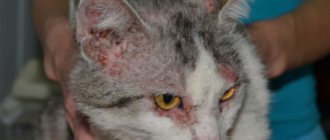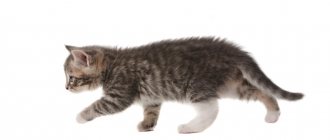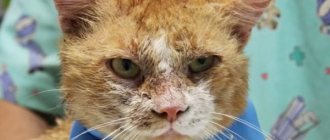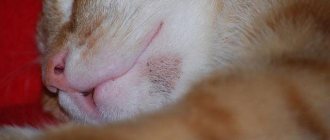Have you noticed dry, hard pustules or rashes on your cat? If so, these are crusts or scabs and can range from single to multiple. There are many different types of crusts that occur for different reasons.
The location of the crusts and the symptoms your cat experiences will help your veterinarian determine the cause. With that said, in this guide we will look at scabs in cats and how to treat them, including some useful home remedies for scabs in cats.
Allergic reaction
Allergy to food
Allergy is an inappropriate reaction of the body to an irritant. Atopic dermatitis is an innate predisposition to the influence of external irritants - pollen from flowering plants or the odors of tobacco smoke, perfume, and household chemicals. The cat develops a cough, runny nose, watery eyes, and itchy skin. When your pet scratches its skin, bacteria, as well as fungi, enter the wounds from the air or fur and multiply. The itching intensifies, the cat itches, ichor secretes, dries out, and crusts form.
The mechanism of development of contact dermatitis is the same as atopic dermatitis, only this pathology is acquired. If a cat was attacked by fleas, and the owner washed the windows with a household chemical, then the cat’s body would remember this smell. The fleas were driven out. The windows were washed again and the cat developed an allergy to the chemical.
Contact dermatitis develops due to the flea collar and the smell of the litter tray. Another type is an allergy to food components. Some component - for example, chicken or soy proteins, gluten, milk, chicken eggs - cause irritation.
As the allergen is consumed over a period of several months, its concentration reaches a threshold value and a skin reaction develops in the form of dermatitis. First, the crusts cover the head and neck; in advanced situations, they can spread to the back.
Treatment consists of interrupting contact with the irritant and using external and internal anti-inflammatory, antipruritic, and antihistamine drugs. In all cases, they switch to a hypoallergenic factory-made feed mixture.
Be sure to read:
The cat has black dots on his chin under the fur: what are they, causes, medications and folk remedies
Prevention consists of regular control of ectoparasites, as well as the use of professional food of at least premium class.
Adherents of natural nutrition should learn how to create a diet and stop feeding the animal food from the table. Atopic dermatitis is incurable. You should purchase kittens from trusted breeders, and if a disease is diagnosed, insist on excluding the parents from breeding.
Diagnostics
The veterinarian’s task is to identify the cause that triggered the allergic reaction. It is very important to provide him with complete information about the living conditions, habits, nutrition, stress suffered and other facts of the cat’s life that can directly or indirectly affect the current problem. After collecting a general history, the following diagnostic measures can be carried out:
- A test to identify fleas, since they often provoke the development of miliary dermatitis. Using a special comb, the doctor thoroughly and thoroughly combs the animal’s fur, after laying it on a white sheet. In addition to the fleas themselves, flea excrement can be found, which, when released into the water, turns it red.
- Checking for the presence of skin parasites is also done by taking a scraping. The procedure is performed with a scalpel (blunt side), after which the skin sample is examined under a microscope. An alternative is to use a special transparent tape that is applied to the affected area and then viewed on a glass slide.
- To exclude/confirm a bacterial or fungal infection, a smear is taken from the problem area and examined in a laboratory setting. To obtain reliable information about the crop taken, it takes an average of 10-14 days. During this time, the required number of culture samples grows, which are used to identify the presence of a particular fungus.
- A stool test can help identify intestinal parasites.
- A general blood test is taken to determine the level of basophils, eosinophils, as well as other indicators indicating the presence of autoimmune disruptions and hormonal disorders.
- If a food allergy is suspected, a diet plan is drawn up, according to which all possible allergens are excluded from daily consumption. Over the course of 2-3 months, foods that made up the cat’s basic diet are added to the food. This way, one (or more) ingredients that are the source of an allergic reaction are identified.
If all of the above examination methods and tests did not help determine the cause of the disease, then additional tests may be prescribed - in particular, to identify a reaction to certain antibacterial, steroid and other drugs. The option of performing a skin biopsy of the animal cannot be ruled out.
Ectoparasites
Human flea dermatitis
Most often, cats suffer from flea attacks. The saliva of blood-sucking insects causes an allergic response characterized by itching. The pet scratches the affected area and flea dermatitis develops.
Microorganisms - permanent inhabitants of the skin - join. The inflammatory process develops according to the scheme described above. Skin parasites - Heyletiella mites feed on the epidermis, causing itching and scratching. Ectoparasites pose a danger to humans. Adult fleas attack people and bite painfully. The larvae crawl from the litter to open areas and feed on the epidermis.
But the greatest harm to humans is caused not by the insects themselves, but by the pathogens of the following diseases, transmitted by all phases of arthropod development:
- brucellosis;
- anthrax;
- typhus;
- helminths;
- tick-borne encephalitis.
Cheyletiella are not so harmful, however, children or old people develop itching after contact with a pet. Ticks cannot stay on cold, hairless human skin for long. If you interrupt contact with your pet, the itching disappears. When restarted it appears again.
Although the biology of parasites is different, the measures to combat them are the same. Adult arthropods and larvae are destroyed with an insectoacaricidal spray. After 8-10 days the treatment is repeated.
Drops of Stronghold
Eggs are immune to poisons. After 8-10 days, the larvae hatch from them, so you need to destroy them before they become sexually mature. External anti-inflammatory wound healing agents are applied to the damaged surface. To speed up healing, pets are switched to veterinary food for cats with skin diseases.
Prevention consists of regular use of Spot-on drops, which protect against ectoparasites and worms.
The danger of skin pathologies for humans
Despite the fact that such diseases are an unpleasant phenomenon, most of them are not transmitted to people. Timely and correct prescription of medications makes them not dangerous for their owners.
Infection with different types of lichen and allergic reactions from blood-sucking bites require the use of medications not only for the animal, but also for the owner. They do not pose a threat to life, but the spread of scabs and ulcers throughout the body of a person or pet is not a very pleasant phenomenon, and it needs prompt treatment.
Subcutaneous mites
Demodex
Most often, the appearance of crusts is associated with the activity of subcutaneous mites Demodex and Notoedrus. Parasites live in different layers of the skin, causing itching, scratching, the addition of microflora, the release of ichor from the capillaries, drying out and the formation of crusts. Both types of mites crawl onto the surface of the skin. Notoedrus move on to a new victim and do not disdain humans. They stay on it longer than Heyletiella, but cannot reproduce. Children, old people, and people with immunodeficiency suffer.
Be sure to read:
Why does a cat bite and gnaw its tail strongly, sometimes until it bleeds? Should I be worried?
Feline Demodex do not infest the owner's skin, probably because they cannot compete with human mites. It should be noted that cats and ticks can coexist peacefully for years, and the disease occurs when the immune system weakens.
Mites are destroyed by applying insecto-acaricidal external preparations to the damaged surface. 4-5 treatments are required at intervals of 5-7 days until the pathological symptoms disappear. Prevention of the disease is the same as for fleas and skin mites.
Bedsores
The disease is often observed in cats in old age or after suffering an injury. Bedsores are areas on the skin that rot and die over time. If the pet is in a lying position for a long time, the disease may manifest itself.
Symptoms: pain when touched, decreased temperature of the dying area, ulcers, color change. It is worth taking preventive measures - periodically turning the cat over after operations, prohibiting sitting on the damaged paw for a long time. Therapy consists of treating wounds, dressings, and removing dead tissue.
Each disease can progress, which leads to the process of virus reproduction. Because of this, the pet suffers, he has problems with sleep and appetite, he becomes less sociable and cheerful.
If your cat develops irritation in the area of its face or body, you should take it to a specialist immediately. Not all cat diseases are not contagious to humans.
Some viruses and fungi can adapt to the organism that is nearby. It is highly likely that if the pet is left untreated, the owner’s immune system may weaken and spots may appear on the body.
Lichen
Ringworm is a disease in which the skin becomes covered with an itchy rash, hair falls out, and crusts form.
The following types of lichen, characterized by the appearance of crusts on the back, are common to cats and people:
- Shearer.
- Pink.
- Red flat.
Ringworm
Ringworm
The disease is caused by micromycetes Microsporum and, less commonly, Trichophyton. Initially, single patches of baldness appear, which gradually grow and cover the entire body. The skin peels off, breaks down, ichor leaks out, and crusts form. Kittens and pets with weakened immune systems get sick. Veterinary care will be required to eliminate pathological signs.
External wound healing ointments and gels are used. For large-scale lesions, Imaverol is effective. Treatment consists of bathing the animal four times at three-day intervals.
Imaverol
To speed up recovery, medicated food is used for cats with skin diseases. Prevention consists of complying with standards for keeping and feeding professional food of at least premium class. Vaccines against fungal diseases have been developed, however, felinologists do not risk using them due to frequent complications.
Pityriasis rosea
The causative agent of the disease is a virus. The disease is inherited. Pink itchy spots cover the entire body. The pathogenesis is the same as for ringworm. Pathological symptoms occur when the immune system is weakened. Children, the elderly, and people with immunodeficiency are isolated from a sick cat.
Treatment is prescribed by a veterinarian. They use antihistamines, external agents, and immunostimulants. Exclude natural food and dry food. Use wet medicinal canned food. The duration of therapy is determined by the veterinarian.
Be sure to read:
Why does a cat shake its ears and head constantly, causes of itching, how to help and what to do
What are the causes of crusts in cats?
As mentioned, scabs can form on your cat's skin for a variety of reasons. Here are some of the most common reasons:
- Skin cancer
- Reaction to an insect bite or sting
- Eosinophilia granuloma complex
- Skin infection
- Abscess
- Pemphigus
- Ringworm
- Scabies
- Allergies
- Cat acne
- Increased sensitivity to flea bites
© shutterstock
Eczema
Weeping eczema
Eczema is a skin disease of the deep and superficial layers. There are dry (chronic) and weeping (acute) forms. In both cases, the purulent exudate dries out and forms crusts.
There are the following causes for the development of eczema:
- Traumatic . Occurs as a result of damage from accessories that rub the skin, burns, frostbite, and arthropod bites. It occurs in a wet form, and after eliminating the causes of the disease, rapid recovery occurs.
- Neuropathic eczema. A congenital anomaly characterized by bilateral dermatitis. It worsens under the influence of stress factors. It is incurable and requires lifelong use of symptomatic medications.
- Reflex eczema. Occurs under the influence of allergens in the saliva of arthropods and contact irritants. Symptoms, treatment and prevention are described above.
- Internal factors. The skin reacts to pathological signals coming from affected internal organs. Clinical manifestations disappear when the underlying disease is eliminated. To speed up recovery, wound-healing external agents and medicated food are used for cats with skin diseases.
Fleas
Blood-sucking parasites (aka fleas) are quite capable of causing sores under the fur on a cat’s neck, and this is one of the most common causes. Insects, whose favorite place is the neck area, bite the animal, which causes severe itching. The cat begins to itch and scratches the bites, turning them into wounds. The situation will only get worse if action is not taken.
With dirty claws, an animal can introduce an infection into the sore, which can lead to purulent inflammation. In addition, the scratched area will attract even more fleas, and they are known to be carriers of all kinds of infection. To avoid serious complications, you need to fight the parasites and only then begin treatment. Today there are a huge number of different flea remedies available :
- special collars;
- pills;
- shampoos;
- sprays;
- powders;
- drops on the withers, etc.
When no trace of parasites remains, the wounds are treated with peroxide, iodine or other antiseptic. If there are purulent formations, you cannot do without the help of a veterinarian and more serious medications.
© shutterstock











